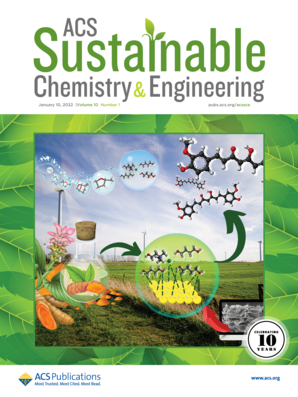Pore Engineering in Hyper-cross-linked Polymers: Directional Etching to Enhance CO2 Adsorption and Conversion
IF 7.1
1区 化学
Q1 CHEMISTRY, MULTIDISCIPLINARY
引用次数: 0
Abstract
Hyper-cross-linked polymers (HCPs) are promising for CO2 adsorption and catalysis. However, optimizing their performance remains challenging. Here, we report a pore engineering strategy to construct hydroxyl-functionalized HCPs-X-HFA (X = 1, 2, or 3) via Friedel–Crafts alkylation followed by hydrofluoric acid (HFA) etching. This approach significantly increases specific surface area and pore volume of HCPs-X-HFA, thereby enhancing CO2 adsorption and CO2/N2 separation selectivity, with up to 3.41 mmol·g–1 at 0 °C. These polymers also serve as recyclable catalysts for CO2 conversion into cyclic carbonates under mild conditions (60 °C, 1 bar CO2) with tetrabutylammonium bromide as a cocatalyst, achieving a yield of 90–99%. The high catalytic activity stems from abundant hydroxyl groups formed postetching, which anchor CO2 via hydrogen bonds and activate epoxides for ring-opening. This study offers insights into designing porous organic polymers with dual CO2 adsorption and catalytic functions.

超交联聚合物的孔隙工程:定向蚀刻增强CO2吸附和转化
超交联聚合物(HCPs)在CO2吸附和催化方面具有广阔的应用前景。然而,优化它们的性能仍然具有挑战性。在这里,我们报告了一种孔工程策略,通过Friedel-Crafts烷基化和氢氟酸(HFA)蚀刻来构建羟基功能化的HCPs-X-HFA (X = 1,2或3)。该方法显著提高了HCPs-X-HFA的比表面积和孔体积,从而提高了CO2吸附和CO2/N2分离的选择性,在0℃下可达到3.41 mmol·g-1。这些聚合物还可以作为可回收的催化剂,在温和条件下(60°C, 1 bar CO2),以四丁基溴化铵为助催化剂,将二氧化碳转化为环状碳酸盐,收率为90-99%。高催化活性源于拉伸后形成的大量羟基,这些羟基通过氢键锚定CO2并激活环氧化物开环。该研究为设计具有双重CO2吸附和催化功能的多孔有机聚合物提供了见解。
本文章由计算机程序翻译,如有差异,请以英文原文为准。
求助全文
约1分钟内获得全文
求助全文
来源期刊

ACS Sustainable Chemistry & Engineering
CHEMISTRY, MULTIDISCIPLINARY-ENGINEERING, CHEMICAL
CiteScore
13.80
自引率
4.80%
发文量
1470
审稿时长
1.7 months
期刊介绍:
ACS Sustainable Chemistry & Engineering is a prestigious weekly peer-reviewed scientific journal published by the American Chemical Society. Dedicated to advancing the principles of green chemistry and green engineering, it covers a wide array of research topics including green chemistry, green engineering, biomass, alternative energy, and life cycle assessment.
The journal welcomes submissions in various formats, including Letters, Articles, Features, and Perspectives (Reviews), that address the challenges of sustainability in the chemical enterprise and contribute to the advancement of sustainable practices. Join us in shaping the future of sustainable chemistry and engineering.
 求助内容:
求助内容: 应助结果提醒方式:
应助结果提醒方式:


